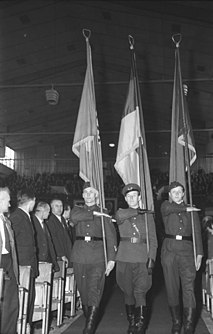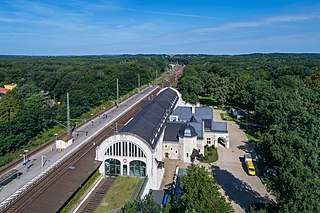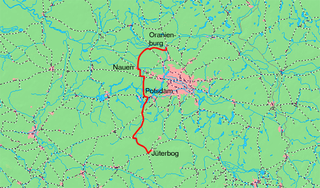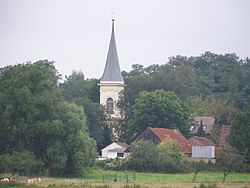
Potsdam is the capital and largest city of the German state of Brandenburg. It directly borders the German capital, Berlin, and is part of the Berlin/Brandenburg Metropolitan Region. It is situated on the River Havel some 25 kilometres southwest of Berlin's city centre.

The National People's Army was the armed forces of the German Democratic Republic (GDR) from 1956 to 1990.

The Deutsche Volkspolizei, commonly known as the Volkspolizei or VoPo, was the national police force of the German Democratic Republic from 1945 to 1990. The Volkspolizei was a highly-centralized agency responsible for most civilian law enforcement in East Germany, maintaining 257,500 personnel at its peak. It was part of the Armed organs of the GDR.

The Federal Police is a (primarily) uniformed police force at federal level of Germany. It is subordinate to the Federal Ministry of the Interior, Building and Community. The Federal Police is primarily responsible for border protection, railroad and aviation/air security. In addition, the agency is responsible, among other tasks, for the protection of federal constitutional bodies. It provides the federal alert police and GSG 9 special police unit, which can also be used to support the federal states of Germany. Ordinary police forces, meanwhile, are under the administration of the individual German states (Bundesländer) and are known as the Landespolizei. In addition to the Federal Police, the Federal Criminal Police Office and the German Parliament Police exist as further police authorities at federal level.

The Bereitschaftspolizei are the support and rapid reaction units of Germany's police forces. They are composed of detachments from the Federal Police and the State Police forces of Germany.

Law enforcement in Germany is constitutionally vested solely with the states, which is one of the main features of the German political system.

Ahrensfelde is a municipality in the district of Barnim, in Brandenburg, Germany. It is situated on the Barnim Plateau at the city limits of Berlin, about 13 km (8.1 mi) northeast of the city centre. The municipal area comprises the villages of Ahrensfelde, Blumberg, Eiche, Lindenberg, and Mehrow.

Babelsberg is the largest district of Potsdam, the capital city of the German state of Brandenburg. The affluent neighbourhood named after a small hill on the Havel river is famous for Babelsberg Palace and Park, part of the Palaces and Parks of Potsdam and Berlin UNESCO World Heritage Site, as well as for Babelsberg Studio, a historical centre of the German film industry and the first large-scale movie studio of the world.

The Kasernierte Volkspolizei was the precursor to the National People's Army (NVA) in East Germany. Their original headquarters was in Adlershof locality in Berlin, and from 1954 in Strausberg in modern-day Brandenburg. They ceased to exist after 1956, having been transformed into the NVA, but are often confused with the later paramilitary police units, the Volkspolizei-Bereitschaft.

Potsdam-Griebnitzsee station is an S-Bahn station in Potsdam on the outskirts of Berlin in the German state of Brandenburg. The station is located in the east of the Babelsberg suburb of the city of Potsdam in the state of Brandenburg, and about 600 metres (2,000 ft) outside the Berlin city boundary. It takes its name from the adjacent Griebnitzsee lake. It is on the Wannsee Railway. During the division of Germany, it served as a border station for traffic to West Berlin. The station is now served by trains on line S7 of the Berlin S-Bahn and Regionalbahn services RB 21 and RB 22. It is classified by Deutsche Bahn as a category 4 station.

Potsdam Hauptbahnhof is the main station in the German city of Potsdam, capital of the state of Brandenburg. It lies on the Berlin–Magdeburg railway and was founded in 1838. However, it has had this name only since 1999. It was originally called Bahnhof Potsdam and it was called Potsdam Stadt (city) station from 1960. The station is the terminus of line S7 of the Berlin S-Bahn, which comes from Ahrensfelde. It is also connected with the central bus station, which is a transfer point between Potsdam and the southwestern region of Berlin, and has a stop on the Potsdam tram network. It is classified by Deutsche Bahn as a category 2 station.

The Volkspolizei served as the armed forces and the national police of the German Democratic Republic from 1946 to 1956. The Volkspolizei was responsible for most law enforcement in East Germany, but because of its organisation and structure it was also considered a paramilitary force. Unlike police forces in most countries, they were equipped with armored personnel carriers and artillery and trained as military units.

Golm is a locality (Ortsteil) of Potsdam, the capital of the German state of Brandenburg. The former municipality was incorporated in 2003. Its name is derived from Western Slavic chulm, meaning "hill", and refers to one of the nearby elevations, either Reiherberg near the centre of the original village or Ehrenpfortenberg east of it.

The Berlin outer ring is a 125 km (78 mi) long double track electrified railway, originally built by the German Democratic Republic to bypass West Berlin in preparation for the building of the Berlin Wall during the division of Germany. It was developed by East Germany for economic, transport policy, and military reasons between 1951 and 1961 and included parts of some older lines.

Willy Riedel was a highly decorated Major in the Wehrmacht during World War II. He was also a recipient of the Knight's Cross of the Iron Cross with Oak Leaves. The Knight's Cross, and its variants were the highest awards in the military and paramilitary forces of Nazi Germany during World War II. He was severely wounded in early 1943 by a grenade splinter and taken prisoner of war by the Soviet Army. Following World War II, he served in the National People's Army of East Germany.

Potsdam Park Sanssouci is a German railway station located in Potsdam, the capital city of Brandenburg, on the Berlin–Magdeburg railway. Named Potsdam Wildpark until 1999, it serves the Sanssouci Park and is famous for the Kaiserbahnhof building.

The Jüterbog–Nauen railway is a line that runs to the west of Berlin through the German state of Brandenburg. It runs from Jüterbog via Treuenbrietzen, Beelitz, Potsdam, Wustermark to Nauen. The line is a part of the Bypass Railway (Umgehungsbahn), which was primarily designed to relieve congestion on the railways in Berlin. The Wustermark–Nauen section has been closed, the Golm–Priort section is now a part of the Berlin outer ring and has been rebuilt as a double-track main line.

Potsdam Pirschheide station is a station on the Berlin outer ring. It was opened in 1958 as Potsdam Süd (south) station and was called Potsdam Hauptbahnhof from 1961 to 1993. In this period it was the most important station on the outer ring after Berlin Schönefeld Flughafen station.

The Brandenburgisches Landeshauptarchiv is the central state archive for the State (Land) of Brandenburg. It is located in Potsdam.
SG Volkspolizei Potsdam, also known as SG Deutsche Volkspolizei Potsdam, or SG der DVP Potsdam, was an East German sports club based in Potsdam, Bezirk Potsdam. The club was founded in 1948 and its football department existed until 1953. Like other sports clubs affiliated with the Volkspolizei, it was incorporated into the SV Dynamo in 1953 and would be reformed as SG Dynamo Potsdam.






















